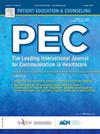“To reach the new generation… TikTok:” Applying behavioral economics to adolescent and young adult HIV pre-exposure prophylaxis education
IF 3.1
2区 医学
Q2 PUBLIC, ENVIRONMENTAL & OCCUPATIONAL HEALTH
引用次数: 0
Abstract
Objectives
To investigate how adolescents and young adults (AYA) would respond to the framing of health messages for HIV pre-exposure prophylaxis (PrEP) using principles of psychology and economics (behavioral economics). Our hypothesis was that gain-frame messaging (focused on benefits) would be better received than loss-frame messaging (focused on risks).
Methods
Focus groups were held to determine AYA preferences for messaging around PrEP to design a social media video. Two videos were developed using either gain-frame (emphasized positive effects of PrEP) or loss-frame messaging (emphasized negative consequences of non-use). Thirty AYA were shown the videos and interviewed about their impressions, message framing preferences, and impact.
Results
Interviews were held May – October 2023. Participants ranged in age from 15 to 25 years (mean 21.5 years) and the majority identified as White (70.0 %). Most (80.0 %) identified as cisgender. A third (33.3 %) had ever tested for HIV, none had an HIV diagnosis, and 36.7 % did not feel that PrEP applied to them personally. Thematic findings included: generally positive views of PrEP, AYA would like to see the video in a doctor’s office as this would make it more trustworthy (20 %), and the video would lead them to do additional research. Gain-framed messaging was preferred over the loss-framed video messaging (53.3 %). PrEP efficacy was the most important medical fact presented. AYA disliked advertisement-like or “staged” video elements and favored genuineness and relatability.
Conclusion
AYA preferred gain-framed over loss-frame PrEP messaging, and information on PrEP efficacy delivered by authentic messengers is likely to resonate. Our study generalizability may be limited due to a primarily cisgender and White sample. These findings offer novel insights into AYA perspectives around PrEP messaging for brief videos that could be disseminated through social media for PrEP education.
Practice implications
Health care professionals should consider using social media and gain-framed messages for health education.
TikTok:“将行为经济学应用于青少年和年轻人艾滋病毒暴露前预防教育。
目的运用心理学和经济学(行为经济学)的原理,探讨青少年和年轻人对HIV暴露前预防(PrEP)健康信息框架的反应。我们的假设是增益帧消息传递(关注收益)比损失帧消息传递(关注风险)更容易被接受。方法举行焦点小组,以确定AYA对PrEP相关信息的偏好,以设计社交媒体视频。使用增益帧(强调PrEP的积极作用)或损失帧信息(强调不使用的消极后果)制作了两个视频。三十名AYA观看了这些视频,并对他们的印象、信息框架偏好和影响进行了采访。访谈于2023年5月至10月进行。参与者的年龄从15岁到25岁(平均21.5岁),大多数被确定为白人(70.0 %)。大多数(80.0 %)被确定为顺性别。三分之一(33.3% %)的人曾经做过艾滋病毒检测,没有人被诊断出患有艾滋病毒,36.7% %的人认为PrEP不适用于他们个人。主题调查结果包括:普遍对PrEP持正面看法,AYA希望在医生办公室看到该视频,因为这将使其更值得信赖(20% %),该视频将引导他们进行更多研究。增益帧消息比损失帧视频消息更受欢迎(53.3% %)。PrEP疗效是最重要的医学事实。AYA不喜欢广告式的或“表演式”的视频元素,更喜欢真实性和相关性。结论a更喜欢增益帧而不是损失帧的PrEP信息,真实信使传递的PrEP疗效信息可能会引起共鸣。由于主要是顺性别和白人样本,我们的研究的普遍性可能受到限制。这些发现为AYA在PrEP信息传递方面的观点提供了新的见解,这些简短的视频可以通过社交媒体传播,用于PrEP教育。实践意义卫生保健专业人员应考虑使用社会媒体和收益框架信息进行健康教育。
本文章由计算机程序翻译,如有差异,请以英文原文为准。
求助全文
约1分钟内获得全文
求助全文
来源期刊

Patient Education and Counseling
医学-公共卫生、环境卫生与职业卫生
CiteScore
5.60
自引率
11.40%
发文量
384
审稿时长
46 days
期刊介绍:
Patient Education and Counseling is an interdisciplinary, international journal for patient education and health promotion researchers, managers and clinicians. The journal seeks to explore and elucidate the educational, counseling and communication models in health care. Its aim is to provide a forum for fundamental as well as applied research, and to promote the study of organizational issues involved with the delivery of patient education, counseling, health promotion services and training models in improving communication between providers and patients.
 求助内容:
求助内容: 应助结果提醒方式:
应助结果提醒方式:


